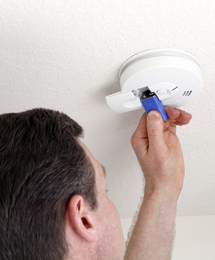 Daylight savings time has ended, and colder temperatures have arrived. Heating systems are running, and we’re spending more time indoors. Now is the time to inspect or install two crucial devices that should be in every home: smoke and carbon monoxide detectors.
Daylight savings time has ended, and colder temperatures have arrived. Heating systems are running, and we’re spending more time indoors. Now is the time to inspect or install two crucial devices that should be in every home: smoke and carbon monoxide detectors.
Smoke detectors have been around since the 1970s. Many studies have shown that working smoke detectors can reduce the chance of you or your family dying in a house fire by 50%! They can save your life.
On the other hand, carbon monoxide detectors have only been around since 1993 and can be life savers like smoke detectors. These detectors protect us from carbon monoxide (CO), a poisonous gas that’s also colorless, odorless, and deadly. The incomplete burning of coal, wood, charcoal, oil, kerosene, propane, and natural gas produces this poisonous gas. To learn more about carbon monoxide poisoning, click here.
Having smoke and carbon monoxide detectors in your home doesn’t automatically mean you and your family will be safe. There are many things to consider.
1. The number of smoke detectors needed and their placement. One working smoke or CO detector in your home will not guarantee your safety. Multiple smoke detectors should be placed throughout your home. According to the National Fire Protection Association (NFPA) standards, you should put smoke detectors here.
- One smoke detector on each floor level;
- One smoke detector in each bedroom; and
- One smoke detector in the bedroom hallway.
Smoke detectors should not be placed in your kitchen or garage because smoke from cooking or exhaust from your car could set them off constantly.
2. The number of CO detectors needed and their placement. Like smoke detectors, the NFPA recommends having more than one CO detector. A CO detector should be placed on each floor level, plus outside each sleeping area. A CO detector should NOT be placed near the water heater and furnace. A small amount of unused natural gas is normal when either starts up. So if your alarm is installed near them, they could be set off constantly. Please remember that the primary role of a CO detector is to alert you of high gas levels.
3. Testing. Fire experts recommend testing your smoke alarm(s) once a month by pressing the test button on the alarm. If the alarms in your home are interconnected, one push of the test button should set all of them off. If they’re not connected, press the test button on each alarm. If your alarm doesn’t go off after pressing the test button, the batteries in the alarm should be replaced. Never use an open flame to test your alarm(s).
4. Maintenance. Smoke and CO detectors require very little maintenance; however, it’s good practice to change your batteries twice a year, when Daylight Savings Time begins and ends. It’s also a good idea to occasionally vacuum away dust and cobwebs in the area around your detector.
5. Replacing detectors: Smoke detectors last about ten years. Experts recommend replacing them after ten years, even if they work fine. The manufacturer of my CO detector recommends replacing it after seven years. Always refer to the instruction manual for your smoke and CO detectors to know when to replace them.
6. Nuisance. Remember that a disconnected smoke alarm does not protect you or your family.
Smoke and carbon monoxide detectors are inexpensive, but their value can be priceless if they save your life. So make sure you use and maintain them properly.
Click on the links below for detector reviews, as well as pricing information.
The Best Smoke Detectors for Your Family’s Protection
The 10 Best Life-Saving Carbon Monoxide Detectors
Do you have any suggestions or tips you’d like to share? I’d love to hear from you. Please share them in the box below.





